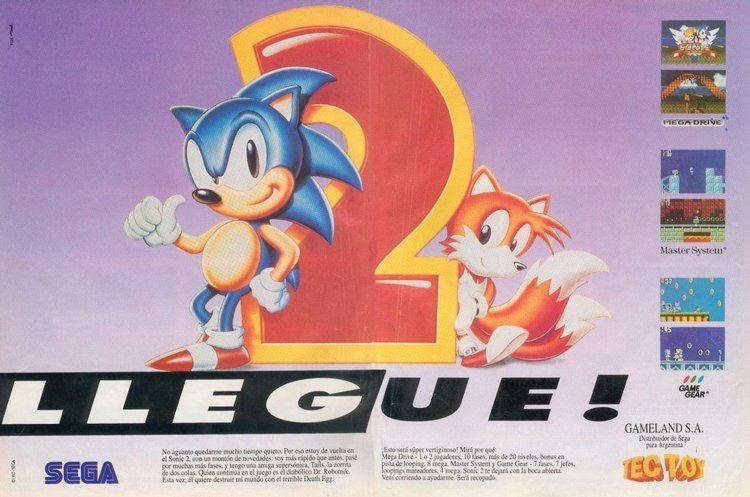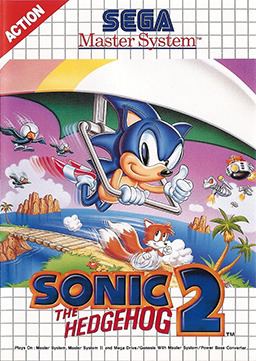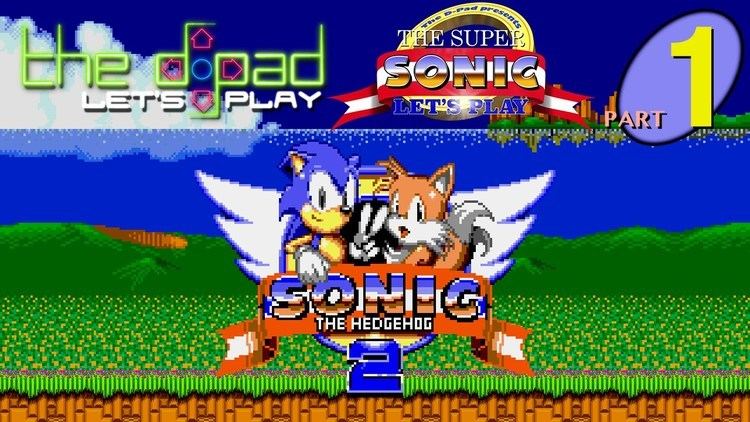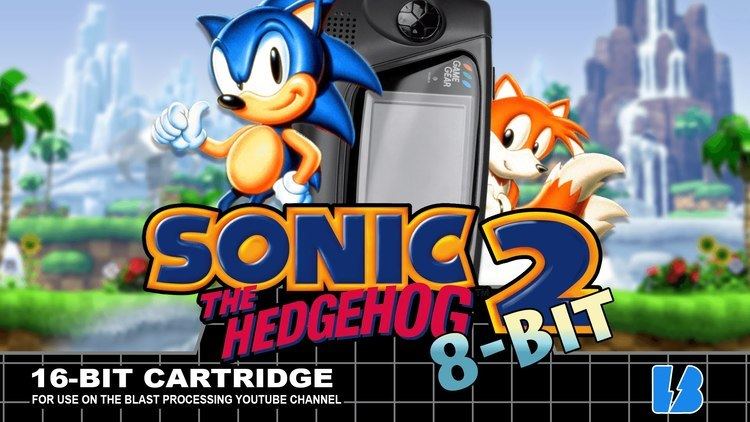Mode(s) Single player Genre Platform game | Initial release date 16 October 1992 | |
 | ||
Composer(s) Naofumi HatayaMasafumi Ogata Similar Sonic the Hedgehog games, Sonic Team games, Platform games | ||
Sonic the Hedgehog 2 (ソニック・ザ・ヘッジホッグ2, Sonikku za Hejjihoggu Tsū) is a side-scrolling platform video game developed by Aspect and published by Sega for the Master System and Game Gear. The Master System version was released in Europe on October 1992. The Game Gear version was released first in Europe in October 1992, and in North America and Japan in the following month.
Contents

Being released before the 16-bit version for the Sega Genesis, the 8-bit editions of Sonic the Hedgehog 2 represented the debut of character Miles "Tails" Prower, who became a recurring character in the series. The Master System version was released for the Wii's Virtual Console in 2008.

Plot
South Island has been peaceful since Dr. Robotnik's defeat. Sonic, bored, decides to go on a journey in search of other adventures. Upon his return, he is shocked to find the island nearly abandoned. The only clue as to where all his friends might have disappeared to was Tails being chased by Dr. Robotnik. Sonic chases after him, but he is too late to save Tails. Sonic finds out that he's been kidnapped by Dr. Robotnik and is being held in a place called Crystal Egg. The price for Tails' safe return are the 6 Chaos Emeralds, to be delivered to 6 new boss robots. Thus, Sonic goes on a quest to find the Chaos Emeralds and rescue Tails.
Gameplay

Like the previous games, players control Sonic the Hedgehog as he makes his way through each of the game's seven zones, fighting against various badniks and overcoming deadly obstacles. By collecting rings, Sonic can protect himself from damage against enemies and obstacles (with the exception of pitfalls and drowning), with extra lives earned for collecting 100 rings. Unlike the previous 8-bit title, Sonic is now able to recollect some of his rings for a limited time after being hit. Other technical improvements allow Sonic to smash through certain walls and run through loops. Also added to this iteration are gameplay mechanics unique to certain zones, such as riding a mine cart, using a hang glider to glide across the air, skimming across the surface of water and floating inside giant bubbles to reach higher areas. Unlike the previous game, the game no longer features the Shield and Restart Marker items.

Each of the game's seven zones consist of three acts, the third of which consists of a boss battle (most of which now consist of animal-based robots as opposed to direct confrontations with Dr. Robotnik) in which the player is not given any rings to collect. At the end of each of the first two acts, players can potentially earn bonuses such as additional rings, lives and continues by fulfilling certain criteria upon hitting the act's goal post, such as having a specific amount of rings. In the first five zones, a Chaos Emerald is hidden somewhere within the second act. These five emeralds, along with a sixth earned from defeating the sixth zone's boss, are required to access the game's seventh zone and ultimately achieve the game's good ending by defeating the game's final boss. Otherwise, the game will end after the sixth zone, with Sonic unable to rescue Tails.
Development
Sonic the Hedgehog 2 received preview coverage in the October 1992 issue of GamePro.

The Game Gear's lower screen resolution results in the Game Gear version having a smaller visible screen area than the Master System edition, causing some fans to consider the Game Gear version the more challenging title. For example, when facing the boss of the Underground Zone, the reduced screen area either side of Sonic gives the player less time to react to hazards moving onto the screen. Other bosses were also affected: the Green Hills Zone battle takes place in a smaller, steeper arena; there is a 3rd chute which cannot be seen while fighting Robotnik in the final Crystal Egg stage.
The music for the intro sequence is also different. The Game Gear version uses the Scrambled Egg Zone music for the scene showing Robotnik escaping with the captive Tails and the Master System intro music for the title. The boss music is also different between the two versions. The Master System version used a single theme for the endings while a new good ending theme was added for the Game Gear version.
The Game Gear version also features dark blue (instead of green) water in the second Act of the Aqua Lake Zone, and omits the game's only "Speed Shoes" item box, which may be found only in the Master System version of this stage; instead, in the Game Gear version there is a Ring item box in said power-up's original location, thus rendering the item unused in said port.
The game's music was written by Naofumi Hataya and Masafumi Ogata, with Tomonori Sawada, in his first game project, contributing the theme for the Crystal Egg Zone. Hataya and Ogata would later collaborate to compose the original soundtrack for Sonic the Hedgehog CD, with Ogata's theme for Green Hills Zone being used as the basis for Sonic CD's opening theme song "Sonic - You Can Do Anything".
Re-releases
The Game Gear version was included as an unlockable bonus in Sonic Adventure DX, released in 2003 for Nintendo GameCube and Windows, and as one of the game's featured in the Sonic Gems Collection, released for GameCube and PlayStation 2 in 2005. The game was later re-released on Nintendo's Virtual Console service, with the Master System version released for the Wii Virtual Console in December 2008 and the Game Gear version released for the Nintendo 3DS eShop in June 2013.
Reception
Sonic the Hedgehog 2 for the Master System and Game Gear has been critically acclaimed since release. The Master System version received a positive review from Mean Machines, which described it as better than its predecessor and as "one of the greatest Master System games of all time," giving it an overall 95% score. Mega Zone gave this version an overall 93% score, with reviewer Steward Clark stating that it is "radically different to the Mega Drive version" but still "another winner!" He praised the "superb gameplay" and described it as a "classic in its own right." Sega Force gave the Master System version a 92% score, noting that instead of "trying to scale down the MD version," Sega have "opted for a totally different game — and well good it is, too!"
The Game Gear version received a positive review from GamePro staff writer The Unknown Gamer, focusing praise on both the gameplay and the impressive graphics for the small handheld console. It gave the game scores of 5 for graphics, 4 for sound, 4.5 for control, and 5 for overall fun factor. Sega Force gave the Game Gear version a 93% score, describing it as the "most challenging" and "toughest version of Sonic 2." French magazine Mega Force also gave the game a positive review. In 1993, it was awarded as the Best Portable Game of 1992 by Electronic Gaming Monthly.
Reviewing the Master System version for its Virtual Console release, IGN gave the game a score of 8.0 out of 10. The reviewer Lucas M. Thomas stated that many Wii owners may "erroneously assume that it's a technically inferior port of the Genesis classic with the same name. It's not." He described the Master System game as "entirely its own adventure" with its own "unique elements like mine carts and hang gliders," concluding that it is "a hidden gem from Sonic's early years."
